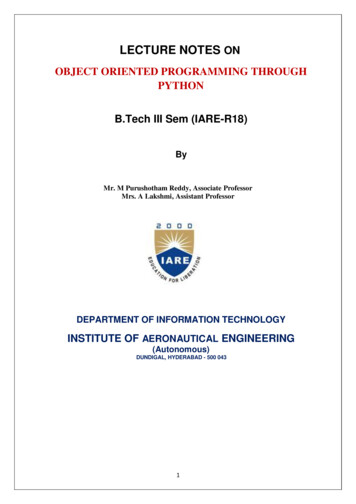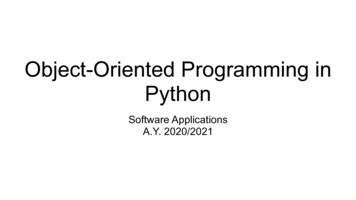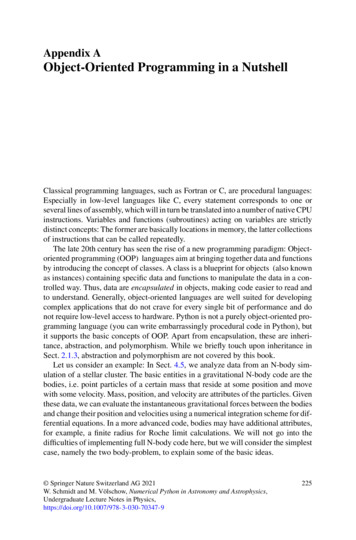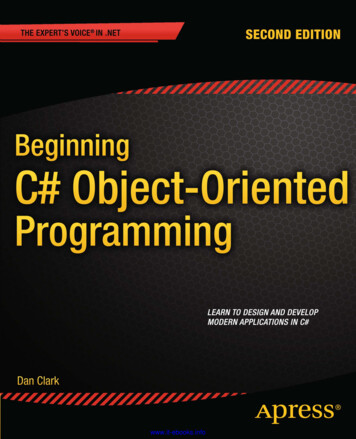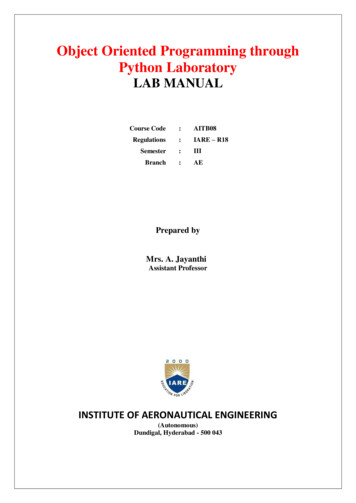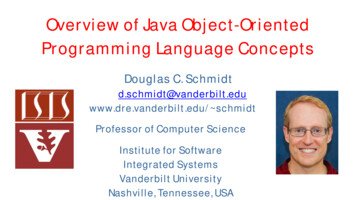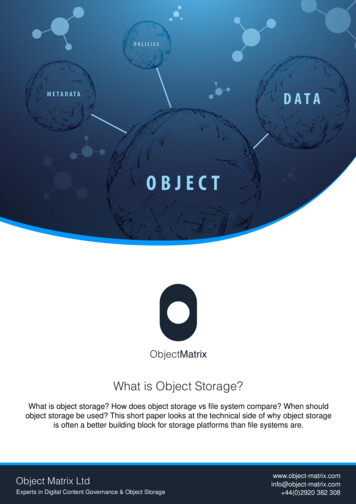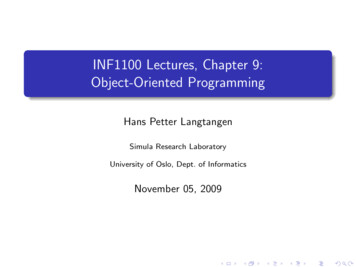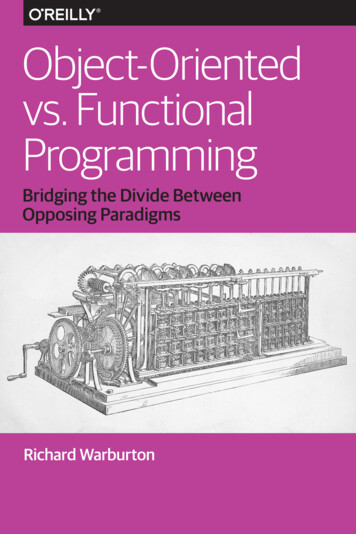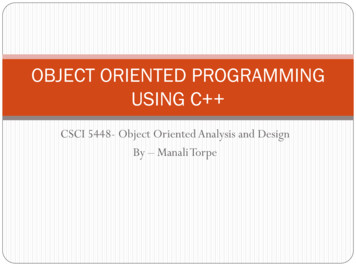
Transcription
OBJECT ORIENTED PROGRAMMINGUSING C CSCI 5448- Object Oriented Analysis and DesignBy – Manali Torpe
Fundamentals of OOP Class Object Encapsulation Abstraction Inheritance Polymorphism Reusability
C as an OOP language C : C with classes Multi-paradigm language As Object oriented language, it offers bottom to top approach As Procedural language, it offers top to bottom approach
Classes and objects (I) Class- user defined data type. Fundamental packaging unit of OOP technologyClass declaration is similar to struct declarationKeyword ‘class’ followed by class name.Object is an instance of classObject combines data and functionsObject is created as a variable of class type using class nameMembers of class Data members / attributes Member functions / methods
Classes and objects (II) Structure of C program with class
Data members Data members can be any of the following types Primary data types : int, float, char, double, bool Secondary data types : arrays, pointers, class objects etc. Data members classified into two groups Regular : every object gets its own copy of data members Static: all objects share the same copy of data member
Static Data Members Variable declaration preceded by keyword ‘static’ Only one copy of static variable is created. All the objects share the samecopy Initialized to zero when first object is created. No other initializationpermitted. Should be defined outside the class definition after declaring theminside the class in this way – datatype classname :: varname They are normally used to maintain values that are common to theentire class, e.g., to keep a count of number of objects created.
Methods (I) Function defined inside a class declaration is called asmember function or method Methods can be defined in two ways - inside the class oroutside the class using scope resolution operator (::) When defined outside class declaration, function needs to bedeclared inside the class
Methods (II)Method defined inside theclassMethod defined outsidethe class
Methods (III) Types of functions in a class Regular functions Overloaded functions Inline functions Friend functions Static functions Constructors Destructors Virtual functions
Inline Function (I) It is a function defined with a keyword ‘inline’ Compiler replaces the function call with function definition It can not be recursive It can not contain any types of loops It can not have switch cases or nested if’s It can not have static variable or goto statements Main() can not be inline
Inline Function (II) All the inline functions must be defined before the call,because compiler needs to go through definition beforethe call
Friend Function (I) Non-member function Has access to private and protected data of class. It gets the accessthrough declaration in the class with keyword ‘friend’ It can be declared anywhere in class, i.e., private/public scope It has minimum one object of the class as its parameter because itaccesses data members with the object name It can not be called by an object, because it is not a member function One function can be friend of any number of classes.
Friend Function (II) Friend function example
Friend function (III) Uses of Friend function Useful when overloading certain types of operators Useful when two or more classes contain members that areinterrelated to other parts of program Enhances encapsulation. Only programmer who has access tothe source code of class, can make a function friend of that class
Friend Classes They are used when two or more classes need to work togetherand need access of each other’s data members without makingthem accessible by other classes.
Static and Const Member Functions Static member functions Can have access to only static members of the same class Can be called using class name as –classname :: functionname (); Const member functions Function declaration followed by keyword ‘const’,e.g., void put() const {statements .} It ensures that it will never modify any data members Can be invoked for both const and non-const objects
Constructors (I) Special member function to initialize the objects of its class Automatically called when an object is created Data members can be initialized through constructors Have the same name of the class They can have any number of parameters Do not have return types, because they are calledautomatically by system A constructor can only be called by a constructor
Constructors (II) Three types of constructors Default constructors - constructor with no parameters. Compiler suppliesdefault constructor by itself if not defined explicitly.e.g. Circle() {} . In main function, Circle c. Parameterized constructors- constructors with parameters. Used forinitializing data memberse.g. Circle(float x) {r x;} . In main function, Circle c(3.5); Copy constructors- used when one object of the class initializes other object.It takes reference to an object of the same class as an argument.e.g. Circle (Circle &x) { r x.r;} .in main function, Circle c1(3.5); Circle c2 c1;
Constructors (III) Ways of calling the constructors Implicit call – Calling the constructor by its object. we do not specifythe constructor name (Circle(3.5))e.g. Circle c(3.5); Explicit call – constructor is called by its name with parametersE.g. Circle c Circle(3.5); Dynamic initialization – first memory is allocated to the object usingdefault constructor. Then parameterized constructor is called toinitialize data membersE.g. Circle c; float x; cin x;c Circle(x);
Destructors Special member function that is called implicitly to de-allocate the memory of objects allocated by constructor Has same name of the class preceded by ( )signE.g. Circle() {} Only one destructor in class Can never have parameters and cannot be called explicitly No return type Is called by itself when object goes outside its scope Called in reverse order of constructors
Function Overloading Functions with same name but different parameters All the functions are defined in the same class Binding is done during compile time
Operator Overloading (I) Mechanism in which we give an additional meaning toexisting operators when they are applied to user defineddata types e.g. objects When an operator is overloaded, its original meaningsare not lost Improves readability of code and increases scope ofoperator.
Operator overloading (II) General rules of operator overloading Only existing operators can be overloaded Overloaded operator must have at least one user definedoperator Operator function can not have default arguments All binary arithmetic overloaded operator functions explicitlyreturn a value Precedence of operators can not be altered. E.g. * has higherprecedence over
Unary Operator Overloading (I) Unary operator acts on single operand( ,--) Can be overloaded either through non-static memberfunction or friend function Member function – takes no parameter. E.g. x.operator () Friend function - takes one parameter. E.g. operator (x) Increment( ) and decrement(--) have two versions, prefixand postfix. To differentiate between them, a dummyparameter of type int is used in postfix
Unary Operator Overloading (II)Member functionFriend function
Binary Operator Overloading (I)Binary operator is an operator that requires two operands e.g. ,-, Member function – takes one parameter e.g. c.operator (Circle x). Left hand side operand becomes calling object. R.H.S. becomes passing object.e.g. c c1 c2; - c c1.operator (c2); Left hand operand can not be primary data type as it can not call the functionE.g. c 100 c1; //error because c 100.operator (c1) not possible Friend function – takes 2 parameters. One parameter has to be user-defined data type. Other can be eithersecondary or primary data typee.g. operator (Circle c, int n) Both L.H.S and R.H.S. are passed as objects, L.H.S. as 1st parameter and R.H.S. as 2ndparametere.g. c c1 100; - c operator (c1,100) In case of one of the operands being primary data type, object may appear on either left or rightside of operator.e.g. C 100 c1; - c operator (100,c1) Return type in general is the object of the class
Binary Operator Overloading (II) Assignment operators – e.g. , ,- ,* etc Assignment operator functions do not return any value. Changes aremade in L.H.S. operand In case of friend function, first parameter must be an reference to theobject e.g. Speed operator (Speed &x, Speed y)s1 s2; - operator (s1,s2); If an object is assigned to another object at the line of declaration, thencopy constructor is called. E.g. Speed s1 s2; If it is done on the next line of declaration, then operator is called. E.g. Speed s1;S1 s2;
Inheritance (I) It is a concept in which the properties of one class areavailable to another The class that is being inherited is called as superclass orbaseclass The class that inherits the properties and functions ofbase class is called as subclass or derived class Derived class inherits all the properties of baseclasswithout making any changes to it. So facilitates codereuse, hence reusability
Inheritance (II) An access specifier defines a boundary to member of a class. A class can have 3 types of member access specifiers: Private: members of class accessible only by members & friends of class. Bydefault, all members are private Protected: members of class accessible only by members and friends ofderived class. Public: members of class accessible by any function in the application
Inheritance (III) Base-class access specifier determines access status of base class members inside derived class3 types of base class access specifiers:Private – all public, protected members of base class become private in derivedclass. Inaccessible by derived class objectsProtected – all public, protected members of base class become protected inderived class. Accessible only by members and friends of derived classPublic – public members become public in derived class, hence accessible byderived class objects. Protected remain protected.
Inheritance (IV) Class can inherit properties of one or more classes or frommore than one level. Depending on the number of base classes and number oflevels, 5 Types of inheritance: Single inheritance Multilevel inheritance Multiple inheritance Hybrid inheritance Hierarchical inheritance
Single Inheritance Derived class has only one base class All properties of base class are available in derived class.But vice versa not true Object of derived class can access all public properties ofbase class
Multilevel Inheritance Derived class becomes base class to another class Here B is called intermediate base class All the public properties of A are available in C Private properties of A not accessible in C
Multiple Inheritance Derived class has more than one base class Derived class has all the public and protected propertiesof all the base classes Each base class can be inherited with any visibility mode.All are separated by a comma
Hybrid Inheritance Derived class has multiple base classes These intermediate base classes have a common base class To avoid getting multiple copies of common base class in the derived class,intermediate base classes inherit the base class as virtual Hence only one copy of base class will be given in derived class
Hierarchical Inheritance Different derived class inherits one level of inheritance Additional members are added in each derived class to extend thecapabilities of class Each derived class serves as base class for lower level of classes
Constructors and Destructors inInheritance Single and multilevel inheritance – base class constructors arecalled first, then derived class constructors are called E.g. class B : public A Constructor of A is called first, then of B. Multiple inheritance – base class constructors are called from leftto right as specified in derived class inheritance list. Then derivedclass constructors are called. E.g. class C : public A, public B Here constructor of A is called first, then constructor of B is calledand then of derived class C Destructors are called in the reverse order of constructors
Encapsulation Means of data hiding Binds together code and data it manipulates and keeps bothsafe from outside interference. Tells exactly what user can access and can not access throughpublic and private access specifiers Prevents hacking of code.
Function Overriding (I) Functions with same name and same parameters and samereturn type Defined in base class and derived classes When derived class object calls the function, it callsoverridden function in the derived class When base class object calls the function, it calls the baseclass copy of the function
Function Overriding (II) Example of function overriding
Virtual Functions (I) Member function preceded by keyword ‘virtual’ in base class and overridden in derived classIf object of base class invokes virtual function, then copy ofbase class is invoked and if derived class object invokes it,then copy of derived class is invoked.Virtual functions are declared to specify late binding.When base class pointer points at derived class object, c determines which copy to be called depending upon the typeof the object at run timeThey are resolved at run time not at compile time
Virtual Functions (II) General rules while defining virtual function: Must be member of some class Accessed using object pointers Can be friend of another class Prototype of base class and derived class virtual function mustbe identical No need to use keyword ‘virtual’ in definition if its is definedoutside the class Can not be a static member
Polymorphism (I) Function overriding with base class function declared virtual Always needs to be called with base class pointer or reference When derived class object is assigned to base class pointer,base class pointer will access the overridden derived classfunction during run time This is know as run time polymorphism / dynamic binding
Polymorphism (II) Example of polymorphism
Pure Virtual Function Virtual member function of base class without definition andforces derived class to give definition for it Should be overridden in all the derived classes Is initialized to 0. “ 0” indicates that code for the function isnull pointer. E.g. class Shape{ virtual void area() 0;}; If derived class fails to provide definition for the function,then it becomes an abstract class and instance of it can not becreated then.
Abstract Class (I) Contains at least one pure virtual function Object of abstract class can not be created, because itcontains one or more pure virtual functions withoutdefinition. A reference or pointer can be created to support runtime polymorphism All the pure virtual functions of abstract class must beoverridden in derived class. Can be used to create generic, extensible libraries forprogrammer to use in their own implementations
Abstract Class (II) Example of abstract class. Similarly, another sub class Trianglecan also be added.
Overview We learnt the basics of object-oriented programming usingC language Following key features were explained with examples: Inline functionsFriend functionsOperator tual functionsAbstract class
Inheritance Single and multilevel inheritance - base class constructors are called first, then derived class constructors are called E.g. class B : public A Constructor of A is called first, then of B. Multiple inheritance - base class constructors are called from left to right as specified in derived class inheritance list.
